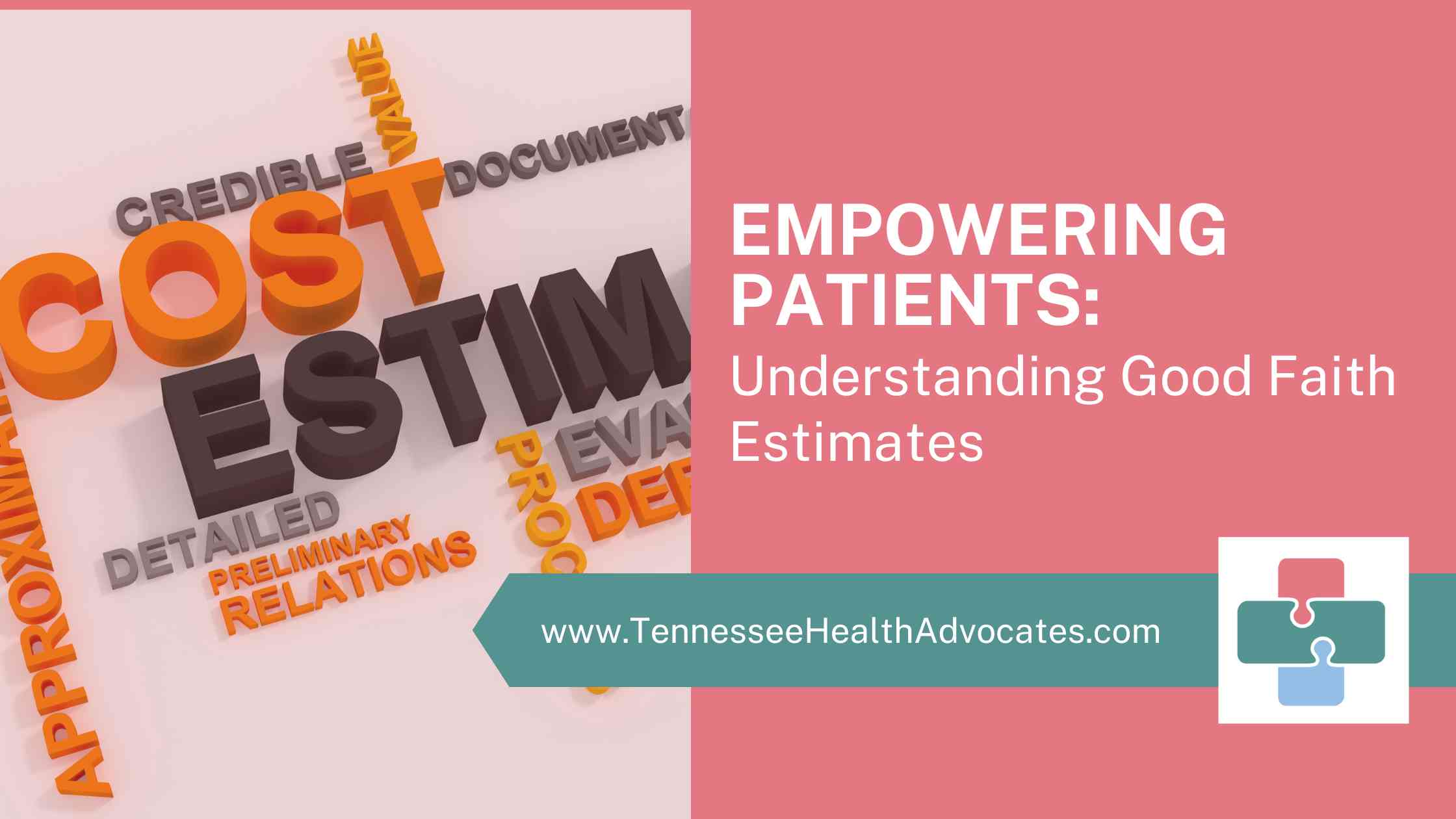Introduction:
Knowing how much medical treatments cost is really important for us as patients patients. It helps us make smart choices and prevents surprise bills. Good Faith Estimates (GFEs) are super helpful for this. It breaks down expected costs for procedures, so we can plan and budget better. In this blog, we’ll talk about why GFEs are important and how they help us manage our healthcare money.
What is a Good Faith Estimate?
A Good Faith Estimate (GFE) serves as a reference point in the confusion of healthcare billing. If used well, it can assist us in anticipating costs associated with our medical services. This breakdown of expected expenses serves two purposes. It provide us with a clearer understanding of the financial implications of our healthcare decisions and it also provides much needed information to plan and prepare for expenses effectively. In an era where healthcare costs continue to rise, GFEs can play a major role in empowering all of us to navigate the financial aspects of our healthcare with confidence and clarity.
Legal Requirements and Regulations
The Good Faith Estimate (GFE) is backed by laws that protect patients and make healthcare costs clear. One important rule, set by the Centers for Medicare & Medicaid Services (CMS) in the No Surprises Act (NSA), says that healthcare providers must give uninsured patients clear estimates of costs before they get treatment. These rules help patients understand what they’ll pay, making healthcare costs easier to handle. They’re like a shield, keeping us from unexpected bills and helping us make smart choices about our healthcare.
In addition, the HITECH Act, which started in 2010, lets you limit healthcare providers from sharing your medical info for anything other than your treatment. This includes not sending claims to your insurance. So, if you choose not to have insurance, you can get estimates of costs and pay cash. You can find forms online to make or cancel this choice. Just remember, if you do this, you’ll have to pay the full cost of your healthcare. Deciding when to do this is a whole other topic. Stay tuned for more on that! Also, there might be new advice from CMS about cost estimates for insured patients later this year. I’ll share any updates. For now, let’s keep talking about cost estimates as they are now.
Key Components of a Good Faith Estimate
Unlocking the potential of a Good Faith Estimate (GFE) requires understanding its building blocks. Let’s review the essential components that comprise a GFE. Thus empowering you with the knowledge you need to navigate their healthcare expenses confidently:
Procedure/Service Details:
At the heart of every GFE lies a detailed description of the medical service or procedure in question. This includes pertinent information such as the nature of the treatment, the healthcare provider performing the service, and any associated medical codes or terminology to ensure clarity and accuracy.
Estimated Costs:
Following the service details, the estimated costs section is a vital part of being transparent about healthcare expenses. It breaks down all the expected costs for a medical service, like consultation fees and surgical supplies. This helps patients understand exactly what they’ll be paying for. It’s important to ask for a Good Faith Estimate (GFE) from each service provider because there’s no rule requiring a complete GFE that includes charges and services from all providers. For instance, if you’re having outpatient surgery, you’ll need to ask for a GFE from the surgery center, the surgeon, the anesthesiologist, and any other providers involved in the procedure.
Explanation of Any Additional Factors Impacting Costs:
In addition, GFEs not only cover the basics but also reveal other factors that might affect your healthcare bill. Keep in mind, though, unexpected changes in treatment can lead to different charges. Understanding these details helps you use GFEs to confidently manage healthcare costs.
How to Obtain a Good Faith Estimate
Obtaining a Good Faith Estimate (GFE) may seem daunting at first glance, but with the right knowledge and approach, you can navigate the process with ease. Here’s a step-by-step guide to help you get the GFE you need:
Know Whom to Contact:
First, find out who to talk to about your medical bills. You might need to contact your doctor’s office, the hospital billing department, or your insurance company, depending on what treatment you’re getting.
Provide Key Information:
When asking for a GFE (Good Faith Estimate), make sure to give all the important details about the healthcare service or procedure you’re planning. This could be things like the procedure code, when you expect to have it done, and any insurance info that matters. The more details you share at the start, the easier it’ll be to get an accurate GFE.
Be Persistent:
Occassionally, getting a GFE might take some effort from you. If you face delays or problems in getting the estimate, don’t hesitate to check back with your healthcare provider. Remember, you deserve to know what healthcare will cost, and being proactive can make sure you get the details you need to make smart choices about your health.
Review and Clarify:
After you get your GFE, make sure to go through it carefully. If there’s anything you don’t understand, ask for clarification. Don’t hesitate to inquire about the costs, insurance coverage, or anything else that might affect the final estimate.
By following these steps and speaking up for your right to know healthcare costs upfront, you can better manage getting a cost estimate and feel confident in making choices about your healthcare.
Benefits of Good Faith Estimates for Patients
While Good Faith Estimates (GFEs) are more than just numbers on a page, they’re also powerful tools that in numerous ways. Let’s explore the many benefits that GFEs offer to patients navigating the complex terrain of healthcare costs:
Empowerment:
GFEs serve as tools for informed decision-making in healthcare. By providing patients with clear and comprehensive estimates of anticipated costs, GFEs enable us to weigh our options, explore alternatives, and ultimately make choices that align with our healthcare needs and financial realities.
Financial Planning:
In an era where healthcare costs continue to soar, the ability to plan and budget effectively for medical expenses is important. GFEs arm us with the knowledge we need to anticipate and prepare for healthcare costs upfront, allowing us to create realistic budgets, explore financing options, and make informed decisions about our care without fear of unexpected financial burdens.
Avoiding Surprises:
Few things are as unsettling as receiving an unexpected medical bill, especially one that far exceeds what was initially anticipated. GFEs serve as a safeguard against such unpleasant surprises, offering a clear understanding of our financial obligations before undergoing medical procedures or services. By providing transparency into potential costs, GFEs empower us to navigate our healthcare journey with confidence, knowing that we’re equipped to manage our financial responsibilities effectively.
As a result, Good Faith Estimates aren’t just about dollars and cents—they’re about empowerment, financial security, and peace of mind. By understanding the intricacies of GFEs, we can embark on our healthcare journey with clarity, confidence, and the knowledge that we’re in control of our financial destinies.
Challenges and Limitations
While Good Faith Estimates (GFEs) offer valuable insights into healthcare costs, they are not without challenges and limitations. Let’s explore some of the common obstacles you may encounter when seeking GFEs:
Obtaining Accurate Estimates:
One of the primary challenges you may face is obtaining accurate GFEs from healthcare providers. Factors such as variability in pricing, complex billing practices, and challenges in communication between providers and insurers can all contribute to inaccuracies in GFEs, making it difficult to rely on these estimates as a true reflection of their potential healthcare costs. This is why it is essential to ask questions and confirm your understanding of the GFE provided.
Variability in Actual Costs:
While GFEs provide us with estimated costs for healthcare services or procedures, it’s essential to recognize that these estimates may not always align with the actual costs incurred. Factors such as unforeseen complications during treatment, changes in medical protocols, and fluctuations in pricing for medical supplies or services can all contribute to variability in actual costs, potentially leading to discrepancies between the estimated and final expenses.
Potential for Unforeseen Expenses:
Even when we try our best to get accurate cost estimates for medical treatment (called GFEs), patients might still face surprise bills not mentioned in the original estimate. These unexpected expenses could come from things like extra tests or procedures needed during treatment, or mistakes in billing that need fixing later on. These surprises can mess up patients’ financial plans, showing how important it is to stay alert and advocate for yourself when dealing with healthcare costs.
Knowing about these challenges and limitations helps you approach getting and understanding cost estimates with a careful eye. It also helps to understand that estimating healthcare costs can be uncertain.
Tips for Using Good Faith Estimates Effectively
Harnessing the full potential of Good Faith Estimates (GFEs) requires more than just obtaining the document—it requires a strategic approach to interpretation and utilization. Here are some tips to help patients make the most of their GFEs:
Understand the Fine Print:
When reviewing a GFE, take the time to understand each component thoroughly. Pay attention to details such as procedure codes, itemized costs, and insurance coverage breakdowns. By familiarizing yourself with the nuances of the estimate, you can better interpret its implications for your healthcare expenses.
Compare and Contrast:
Don’t hesitate to shop around and obtain multiple GFEs for the same medical service or procedure. Comparing estimates from different healthcare providers can help you identify cost disparities and make informed decisions about where to seek care.
Ask Questions:
If anything in the GFE is unclear or confusing, don’t hesitate to reach out to your healthcare provider for clarification. Proactive communication is key to ensuring accuracy and understanding, so don’t shy away from asking questions about any aspects of the estimate that require further explanation.
Plan Ahead:
Use the information provided in the GFE to plan and budget for your healthcare expenses accordingly. Factor in your anticipated out-of-pocket costs, insurance coverage, and any other financial considerations to create a realistic financial plan that aligns with your healthcare needs.
Stay Engaged:
Throughout your healthcare journey, stay engaged and proactive in managing your expenses. Keep track of any changes or updates to your treatment plan that may impact the accuracy of the GFE, and communicate promptly with your healthcare provider if you encounter any unexpected developments.
By following these tips and leveraging GFEs as valuable tools in your healthcare decision-making process, you can navigate the complexities of healthcare costs with confidence and clarity. Remember, proactive communication and informed decision-making are the cornerstones of using GFEs effectively to your advantage.
Case Studies or Examples
Real-life examples serve as powerful illustrations of the tangible benefits that Good Faith Estimates (GFEs) can offer to patients in managing their healthcare costs. Let’s explore a couple of scenarios where GFEs have made a meaningful difference:
Case Study 1: Sarah’s Surgical Procedure
Sarah, a 45-year-old mother of two, was scheduled to undergo a surgical procedure to address a chronic health condition. Concerned about the potential financial implications of the surgery, Sarah requested a GFE from her healthcare provider well in advance. The GFE provided Sarah with a detailed breakdown of the anticipated costs, including the surgeon’s fees, anesthesia charges, and facility expenses. Armed with this information, Sarah was able to review her insurance coverage and plan accordingly for her out-of-pocket expenses. By budgeting proactively and exploring financing options, Sarah felt more confident and in control as she approached her surgery date, knowing that she had a clear understanding of her financial obligations upfront.
Case Study 2: John’s Imaging Test
John, a retired teacher on a fixed income, was advised by his physician to undergo an imaging test to investigate a potential health concern. Worried about the cost of the procedure, John hesitated to schedule the test until he obtained a GFE from his healthcare provider. Upon receiving the estimate, John was pleasantly surprised to find that the anticipated costs were within his budget. With the GFE in hand, John proceeded with the imaging test without hesitation, confident that he could manage the financial aspect of his healthcare without compromising on his well-being. The transparency provided by the GFE alleviated John’s concerns and allowed him to prioritize his health without undue financial strain.
These stories illustrate how Good Faith Estimates can empower patients to make informed decisions about their healthcare and prioritize their well-being with confidence. By leveraging GFEs as valuable tools in their healthcare journey, patients like Sarah and John can navigate the complexities of healthcare costs with clarity and peace of mind.
Conclusion
In an era marked by rising healthcare costs and financial uncertainty, Good Faith Estimates (GFEs) emerge as powerful allies in the quest for transparency and empowerment. Through clear and comprehensive breakdowns of anticipated expenses, GFEs arm patients with the knowledge they need to navigate their healthcare journey with confidence and clarity.
As we’ve explored throughout this blog, GFEs offer a multitude of benefits, from empowering patients to make informed decisions about their healthcare to facilitating proactive financial planning and shielding against unexpected expenses. Real-life examples illustrate the tangible impact that GFEs can have on patients’ lives, allowing individuals like Sarah and John to prioritize their health without sacrificing their financial well-being.
Yet, for GFEs to realize their full potential, proactive engagement and advocacy are essential. As patients, it’s incumbent upon us to advocate for our right to transparency in healthcare costs, to actively seek out GFEs from our healthcare providers, and to use this information strategically to make informed decisions about our care.
Therefore, I urge you to embrace the power of Good Faith Estimates. Demand transparency, ask questions, and utilize GFEs to your advantage in managing your healthcare costs effectively. By doing so, we can collectively champion a healthcare system that prioritizes transparency, empowers patients, and fosters a culture of informed decision-making and financial well-being.
Together, let’s harness the transformative potential of Good Faith Estimates to shape a brighter, more equitable future for healthcare—one where patients are empowered, informed, and in control of their healthcare destinies.
Final Thoughts
I hope this post serves as a valuable framework for both patients and independent advocates. If you are a patient and found this helpful, you may want to check out my series on How to Save Money on Your Healthcare or other articles written to assist you in your financial healthcare journey.


